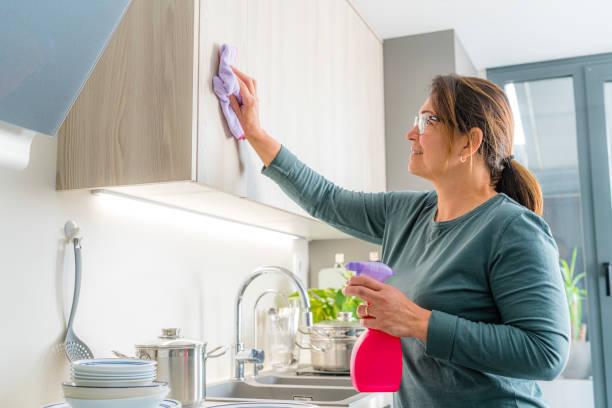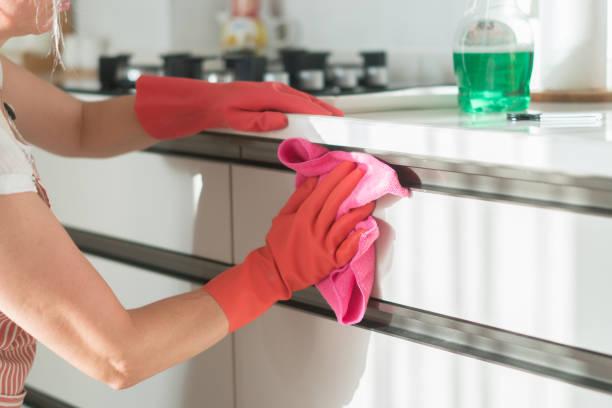Picture this: you’re cooking a delicious, savory meal in your kitchen, the aroma filling the air. But as you reach for a plate, you notice something unsightly—your cabinet door is streaked with grease. Sound familiar? Greasy kitchen cabinets are a common nuisance in most homes. Left unchecked, they can become a breeding ground for bacteria and ruin the appearance of your kitchen.
The good news? It’s easier than you might think about how to clean grease off kitchen cabinets and keep them looking spotless. In this guide, we’ll walk you through some simple and effective methods that make cleaning less of a chore and more of a routine. Let’s get started!

How to Effectively Clean Grease Off Kitchen Cabinets
Grease has a sneaky way of creeping into every nook and cranny of your kitchen. Over time, it becomes a stubborn foe, but with the right tools and techniques, you can banish that grime for good. So how do we start?
Preparing to Clean Your Kitchen Cabinets
Before we jump into scrubbing away, preparation is key. The first step is to gather all the necessary supplies. Here’s a handy checklist:
◆Mild dish soap: A classic cleaner that works wonders on grease.
◆White vinegar: An excellent natural degreaser that breaks down sticky residue.
◆Baking soda: The go-to for scrubbing stubborn stains without scratching.
◆Warm water: Helps dissolve grease and grime.
◆Microfiber cloths or sponges: Non-abrasive cleaning materials for gentle yet effective cleaning.
◆A soft-bristle brush: Helpful for getting into grooves and hard-to-reach corners.
◆A bucket: For mixing cleaning solutions.
◆Commercial degreaser (optional): For particularly stubborn stains.
◆Gloves: Protect your hands from any harsh chemicals, especially if you’re using a commercial cleaner.

Step-by-Step Guide to Cleaning Greasy Kitchen Cabinets
Now, let’s get down to business. Follow this simple guide to clean grease off kitchen cabinets effectively:
1.Create a Cleaning Solution: Mix a few drops of dish soap with warm water. This mild solution is your go-to for the initial cleaning. The soap will break down grease without damaging the finish on your cabinets.
2.Wipe the Cabinets: Dip a soft cloth or sponge into the solution, wring out the excess water, and wipe the surface of your cabinets. It’s essential to go with the grain of cabinets to avoid scratches. Pay special attention to areas around the handles and close to the stove, as they tend to accumulate the most grease.
3.Rinse the Surface: After wiping with soap, rinse the cloth with clean water, wring it out, and go over the cabinets again. This step removes soap residue and prevents streaks.
4.Dry the Cabinets: Use a dry microfiber cloth to buff the cabinets. This prevents moisture from settling, which can warp or damage certain types of wood or finish.
6.Use Vinegar for Stubborn Grease: For cabinets with more persistent grease spots, mix equal parts of white vinegar and water. Vinegar’s acidity works wonders in breaking down tough grease. Apply the mixture to the greasy area, let it sit for a few minutes, then scrub gently with a soft brush.
7.Addressing Small Crevices: Use an old toothbrush or a soft-bristle brush to clean the edges, corners, and crevices of your cabinet doors. These areas often trap grease that a regular cloth might miss.
Techniques to Tackle Stubborn Grease
Sometimes, despite your best efforts, certain spots of grease seem impervious to regular cleaning methods. Fear not! Here are a few trusty techniques that will help you remove even the toughest grease stains.
○Baking soda paste: Mix a tablespoon of baking soda with a few drops of water until it forms a thick paste. Apply this directly to the grease stain and let it sit for 10-15 minutes. Scrub gently with a soft-bristle brush, then wipe clean.
○Vinegar and dish soap combo: Combine two parts vinegar with one part dish soap and apply this mixture to the grease spot. Let it sit for a few minutes before scrubbing. The acidity of vinegar and the grease-fighting power of dish soap make this duo highly effective.
○Heat it up: Warmth can make grease easier to remove. You can use a warm, damp cloth to soften the grease before wiping it away. Be careful not to use water that’s too hot, as it might damage some finishes.
○Oil-Based Cleaner: This might sound counterintuitive, but certain oil-based cleaners can help dissolve grease. A few drops of orange or lemon oil mixed with warm water can break down the grease, leaving your cabinets fresh and citrusy clean.
○Commercial Degreasers: If home remedies aren’t cutting it, there are commercial degreasers available in stores specifically designed for kitchen surfaces. Always check the label to ensure they are safe for your cabinet material.
○These techniques ensure that no grease stain, no matter how stubborn, stands a chance against your cleaning efforts.

Special Considerations for Different Cabinet Types
Not all kitchen cabinets are created equal, and different materials require different care. Here’s how to adjust your cleaning routine based on your cabinet type:
◆Wood cabinets: Wood is porous and can warp with too much water exposure. Use as little water as possible and always dry immediately. A mild soap solution is best, but avoid any harsh cleaners that could damage the wood finish.
◆Laminate cabinets: Laminate is more durable and less likely to warp, but it can still scratch. Avoid abrasive cleaners and scrubbing pads. Stick to soft cloths and gentle cleaning solutions.
◆Painted Cabinets: Painted cabinets require extra caution to avoid damaging the paint. When dealing with stubborn grease, it’s best to test any cleaning solution on an inconspicuous area first to ensure it won’t damage the paint. Never use abrasive materials on painted surfaces.
◆Metal cabinets: Metal cabinets are typically easier to clean, but they are prone to rust. After cleaning, make sure the cabinets are completely dry to prevent corrosion. A solution of vinegar and water works well here, as vinegar helps to shine metal surfaces.
Tips for Maintaining Your Kitchen Cabinets Post-Cleaning
After all your hard work, the last thing you want is for grease to build up again quickly. Here are some tips to keep your cabinets looking pristine:
1.Use liners: Shelf liners can prevent grease from dripping onto the inside of your cabinets. They also make cleaning easier by providing a barrier between the cabinet surface and any food or grease residue.
2.Install range hoods: Range hoods above your stove can help capture grease and smoke before they land on your cabinets. Make sure to clean the hood filters regularly to ensure they are working efficiently.
3.Establish a regular cleaning schedule: Instead of waiting for grease to build up, clean your cabinets weekly or bi-weekly with a mild soap and water solution. This prevents the need for more intensive cleaning down the line.
4.Polish or condition your cabinets: Regularly polishing or conditioning wooden cabinets protects the surface from future grease buildup and keeps them looking shiny.
5.Avoid harsh chemicals: Stick to mild cleaning solutions and natural degreasers. Harsh chemicals can damage cabinet finishes over time, making them more susceptible to dirt and grease.
By incorporating these simple habits, your kitchen cabinets will stay in top-notch condition for years to come.
Conclusion
Cleaning greasy kitchen cabinets doesn’t have to be a difficult task. By following these effective cleaning methods, we can keep our kitchens both beautiful and hygienic. Regular maintenance is key to preventing grease from building up, and with a little effort each day, we can avoid the hassle of deep cleaning. Now that you know how to clean grease off kitchen cabinets, you’re well-equipped to maintain a sparkling, grease-free kitchen space. Happy cleaning!
FAQs
Will grease stains damage my kitchen cabinets if they are not cleaned for a long time?
Yes, grease stains can damage kitchen cabinets over time. They can lead to discoloration, weaken the finish, and attract more dirt, which makes cleaning harder.
How often should kitchen cabinets be cleaned to prevent grease accumulation?
To prevent grease build-up, it’s best to wipe your cabinets down daily or at least weekly with a mild soap and water solution. Regular cleaning ensures that grease doesn’t have a chance to settle and harden.
How should I maintain my kitchen cabinets after cleaning off grease stains?
After cleaning grease stains, maintain your kitchen cabinets by regularly dusting them with a soft cloth and cleaning any spills or splatters immediately. Apply a cabinet-friendly polish or oil every few months to protect the finish and keep the wood or laminate in good condition.

0 Comments